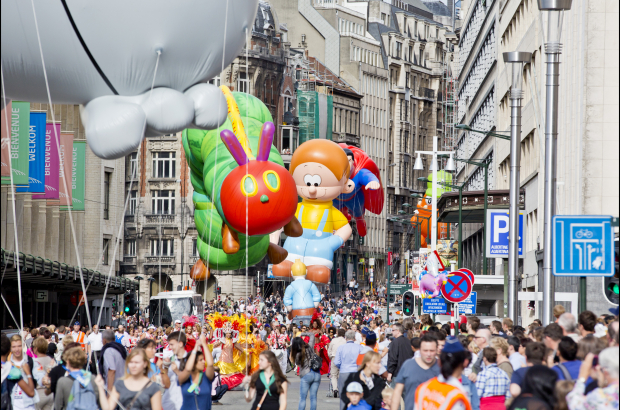- Daily & Weekly newsletters
- Buy & download The Bulletin
- Comment on our articles
Discover why Brussels is in love with its cartoon characters
While Brussels' Comic Strip Festival in September is an annual celebration of what is often known as the 9th art, Brussels boasts sites and activities all-year-round. They include comic book stores, a Comic Strip Walk around some of the best murals in the city centre and museums dedicated to cartoon culture. Belgium is the birthplace of more than 700 working professional comic strip authors, making it the country with the most comic strip artists per square kilometre in the world.
A little history
Why is Brussels such fertile ground for comic strips? "Communication was always tough in this region," explains Willem de Graeve, communications director of the Belgian Comic Strip Center. "We already have this big mixture of languages. People were mixing up languages and they understood very quickly that communication through images, visual communication, was so much easier."

"Of course, there is text, but it’s a lot more accessible than a novel or poetry,” he adds. “It’s not surprising that comic strips fit the Belgian character so well. They came from New York at the turn of the 20th century, which at the time was a crossroads of many different immigrants who only spoke a little English, but they could read the speech bubbles in the strips. When I was a child I was reading comics before I could read, because I was fascinated by the images and I made up my own stories."
The museums
Brussels has three museums dedicated to the comic book: the Comic Strip Museum, the Marc Sleen Museum and the MOOF (Museum of Original Figurines). The first two are conveniently located in Rue des Sables. The Comic Strip Museum is a Horta masterpiece, while the Marc Sleen was designed by one of Horta’s assistants in the Art Nouveau style but with a twist - the ground floor was redone in the 1930s by Brunfaut in the Art Deco style.
"If you are curious to see a museum that is very typical of the country and the city, the Comic Strip Museum is a great place," says De Graeve. "We have two quintessential Belgian art forms with the special architecture of the building and the comic strips. Horta's special genius was in bringing natural light into his buildings and that makes this building perfect for exhibiting comic strips.
"The museum has a mission to promote comic books as a cultural medium, which means also reaching people who are not that interested in comic books. Even if they just come for the building, and they leave with a certain interest, for example, "I’ll read my Tintin books again” or “I saw Brecht Evens' work and I will buy a book by him", then we reached somebody new which is very important. It is no coincidence that the first comic strip museum in the world was founded here in Brussels, showing respect by the Belgian state for these art forms."

One of the features of the museum is its library where visitors can curl up with any number of comic books. Why is it such a special pleasure? "Probably because you have the mix of art forms: you have the visual art but you also have literature and narration and it’s like a movie but more intense. The difference with the movies is that in comics there are a lot of ellipses and you have to use your imagination to complete the story. That makes it more personal."
The Comic Strip Museum has a permanent collection and also shows two or three temporary exhibitions. In celebration of its 30th anniversary, it is running a fun filled action-packed weekend at the beginning of October.
The MOOF, on Rue Marché-aux-Herbes, showcases a unique collection of comic strip figurines, while the Marc Sleen Museum focuses on the work of one artist, one of the founding fathers of Flemish comics with his off-the-wall humour and a Guinness World Record for having produced single-handedly a strip for over 45 years.

The Comic Strip Walk
Take a tour of some of Brussels’ most famous cartoon murals in The Comic Strip Walk, which shows murals in the city centre plus shorter circuits in Laeken, Sablon and Marolles.
The route dates from the 1990s when the city launched a campaign to remove large advertising posters covering walls in the centre. Exposing ugly dilapidated buildings, the city came up with the idea of creating giant murals of Brussels comic book characters.
As the number of murals increased - there are now close to 60 - Brussels artists were joined by Belgian and then some foreign artists. Equipped with a map, you can explore city neighbourhoods while looking up at a variety of murals, which often use the characteristics of each location to create trompe l’oeil or other effects. They come in all shapes and sizes and won’t fail to surprise and impress.

You can find more info on the Comic Strip Walk and other public art in Brussels here.



















